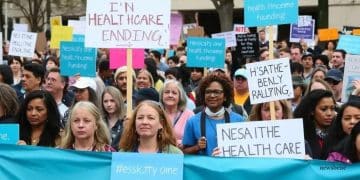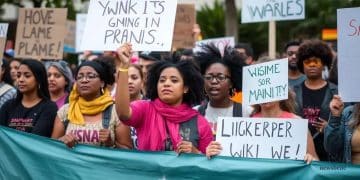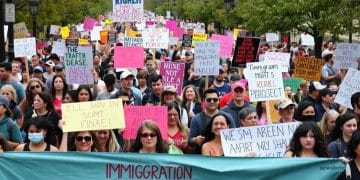Demonstrations supporting reproductive rights: A closer look
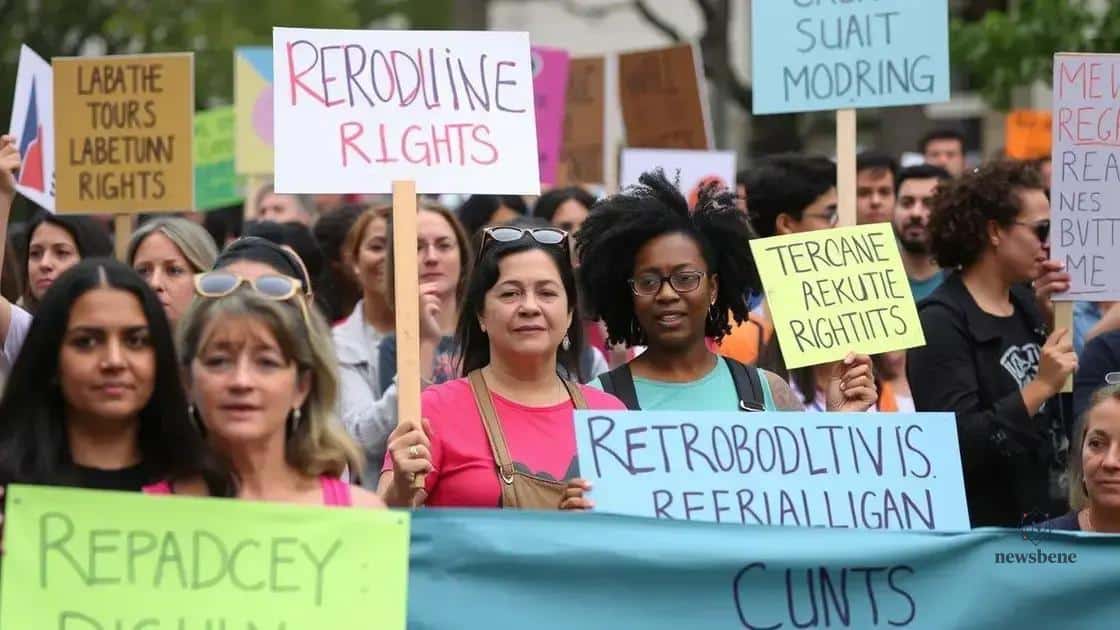
Demonstrations supporting reproductive rights play a crucial role in shaping national policy by mobilizing grassroots movements, increasing awareness, and advocating for women’s autonomy and healthcare access.
Demonstrations supporting reproductive rights have become crucial in advocating for bodily autonomy and women’s rights globally. Have you ever considered how these movements shape policies and individual lives? Let’s dive into their significance.
The history of reproductive rights demonstrations
Understanding the history of reproductive rights demonstrations is vital for grasping the current landscape of women’s rights. These movements have evolved significantly over the decades, reflecting societal changes and the ongoing fight for bodily autonomy.
Early Advocacy for Reproductive Rights
The roots of reproductive rights advocacy trace back to the early 20th century. Activists sought to challenge restrictive laws related to birth control and women’s health. Notable figures like Margaret Sanger emerged during this time, advocating for accessible contraceptives.
From small gatherings to large rallies, early demonstrations aimed to raise awareness about women’s health issues. They set the stage for future activism, emphasizing the need for choice and control over one’s body.
Key Events in the Movement
Several pivotal events have shaped the landscape of reproductive rights:
- The legalization of birth control in the 1960s.
- The landmark Roe v. Wade Supreme Court decision in 1973.
- Annual marches for women’s rights since the late 20th century.
These events not only marked significant legal advancements but also mobilized countless individuals to join the cause. The collective voice of advocates during demonstrations has often inspired change at grassroots and national levels.
Over time, the focus of protests has expanded. Modern demonstrations do not only address reproductive rights but intersect with broader issues, like racial justice and gender equality. This evolution highlights the complexity of advocating for women’s rights in a multifaceted society.
As activists continue to fight for reproductive rights, understanding the roots and events of past demonstrations helps inform current strategies. These historical movements serve as a reminder of the power of collective action. Today, new generations are inspired by the legacy of those who stood for reproductive justice.
Key events that shaped the movement
The key events that shaped the movement for reproductive rights are memorable milestones that encouraged social change. Understanding these significant moments can help us appreciate the progress made and the battles still ongoing.
Landmark Legal Decisions
One of the most critical events was the Roe v. Wade decision in 1973. This landmark ruling by the Supreme Court recognized a woman’s right to choose, effectively changing the legal landscape regarding reproductive rights in the United States. It laid the foundation for ongoing discussions about bodily autonomy.
Other important court cases have similarly influenced the movement, such as Planned Parenthood v. Casey in 1992, which upheld the core of Roe while allowing states to impose certain restrictions.
Significant Protests and Marches
Every year, events like the Women’s March demonstrate the enduring commitment to reproductive rights. These large gatherings unite diverse groups of people advocating for change and equality. They bring attention to the significance of access to reproductive healthcare.
- 1970: The first National Organizing Conference on Women’s Liberation.
- 1992: The March for Women’s Lives in Washington, D.C., attracted over a million participants.
- 2017: The Women’s March, a global protest following the inauguration of a new U.S. president.
These moments have not only mobilized individuals but also garnered media coverage that spreads awareness. Additionally, smaller local protests often play a crucial role, bringing communities together to fight for their rights.
As the movement continues to evolve, each event weaves into the fabric of reproductive rights history. Understanding these key events fosters a deeper appreciation for the ongoing fight for women’s autonomy and healthcare access.
Influential figures in reproductive rights activism
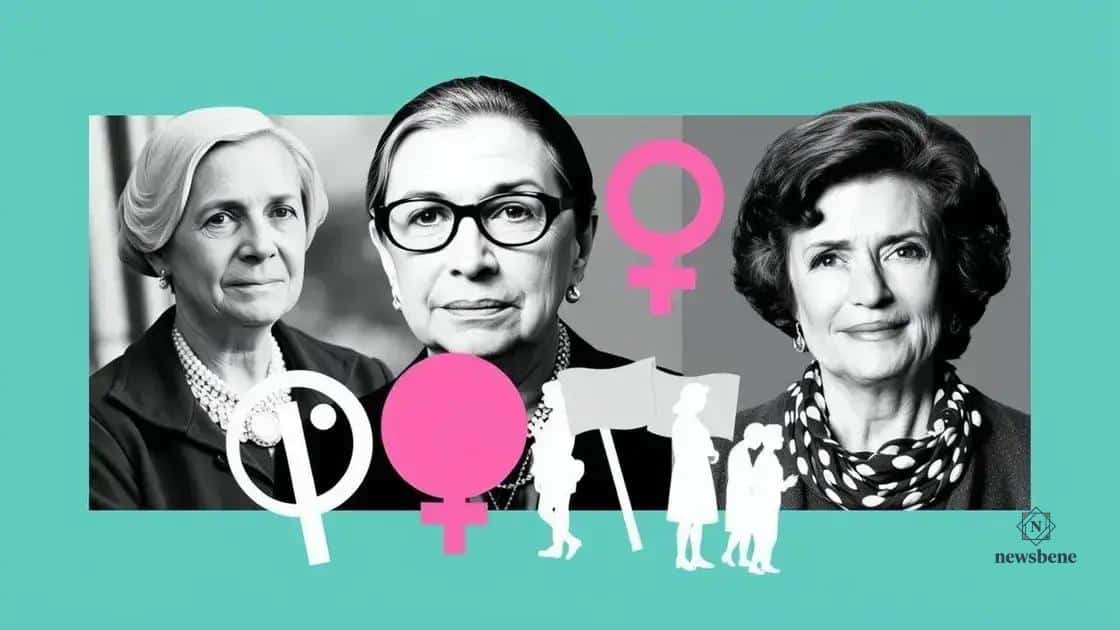
Many influential figures in reproductive rights activism have made significant impacts on the movement. Their dedication to advocating for women’s rights has inspired countless others to join the cause. Each of these individuals has helped shape the conversation around reproductive health and authority.
Margaret Sanger
One of the pioneers in the movement, Margaret Sanger, founded the first birth control clinic in the United States in 1916. She played a crucial role in promoting contraception and founded the organization that later became Planned Parenthood. Her tireless efforts helped bring awareness to women’s health issues.
Ruth Bader Ginsburg
The late Ruth Bader Ginsburg significantly influenced reproductive rights through her work as a Supreme Court Justice. She argued several landmark cases that advanced women’s rights. Ginsburg’s opinions and legal approaches highlighted the importance of gender equality and personal choice.
Gloria Steinem
Gloria Steinem emerged in the 1960s as a leading figure in the feminist movement. As a journalist and activist, she advocated for reproductive rights, emphasizing the need for access to safe and legal abortion. Steinem’s activism has inspired generations of women to fight for their rights.
- Linda Greenhouse: A Pulitzer Prize-winning journalist who reported on the Supreme Court’s role in reproductive rights.
- Bernice Johnson Reagen: A civil rights activist who has worked to intersect reproductive rights with racial justice.
- Marcia Pappas: A former president of the New York chapter of the National Organization for Women, advocating for women’s rights.
These figures represent just a few of the many individuals who have fought tirelessly for reproductive rights. Their contributions inspire current and future activists to continue the work necessary for achieving equality and autonomy in reproductive health.
How local protests impact national policy
The effect of local protests on national policy is profound, especially in the context of reproductive rights. These grassroots movements can catalyze change at a national level by shining a light on critical issues and mobilizing community support.
The Power of Local Voices
Local protests often serve as a platform for individuals to express their concerns and advocate for reproductive rights. When community members gather, their collective voices create a powerful message. This message can resonate beyond local boundaries, drawing attention from media, lawmakers, and advocacy groups.
Media Attention and National Awareness
When local protests gain media coverage, they can influence national dialogue. Reports and articles spread awareness of issues that may not have been widely discussed. This coverage can lead to increased pressure on lawmakers to act. For example, a well-publicized local protest can spark national movements, encouraging people all over the country to join in.
- Local protests can introduce new leaders and fresh ideas into national discussions.
- They often bring new perspectives to policy debates, influencing lawmakers’ viewpoints.
- Successful local campaigns can inspire similar initiatives in other areas, creating a ripple effect.
By showing solidarity and determination, local protests encourage citizens to demand policy changes. This direct action signifies to policymakers that constituents care about their rights and want to see change. As individuals unite around a shared cause, they can shape the future for reproductive rights and beyond.
Additionally, local protests often lead to the formation of alliances with national organizations, helping to amplify their message. This collaboration can create a stronger, more unified front in advocating for policies that support reproductive health access.
The future of reproductive rights advocacy
The future of reproductive rights advocacy holds both challenges and opportunities. As society evolves, so do the conversations surrounding women’s rights and healthcare access. Advocacy groups are adapting their strategies to address new obstacles and advancing technology.
Emerging Technologies
Technology plays a significant role in shaping the future of reproductive rights. Innovations like telemedicine and health apps are making reproductive healthcare more accessible. These technologies allow individuals to seek guidance and support without the barriers of geography.
Additionally, social media is transforming how advocates share their messages. Campaigns can reach broader audiences, engaging more people in discussions about reproductive rights. This accessibility fosters grassroots movements and mobilizes younger generations.
Legal Challenges Ahead
While there is optimism, numerous legal challenges still threat reproductive rights. Changes in legislation can prompt renewed advocacy efforts. For instance, some states are introducing measures that restrict access to abortion and contraceptive services.
- Advocacy groups need to remain vigilant and united to counteract restrictive laws.
- Investing in education and outreach can empower communities to advocate for their rights.
- Collaborating with health professionals will help ensure comprehensive care for all.
As we look toward the future, it is crucial for advocacy groups to adapt and prepare for potential shifts in public sentiment and political landscapes. By fostering inclusive conversations, they can ensure that the voices of marginalized communities are heard and prioritized in ongoing discussions about reproductive health.
In this evolving landscape, the next generation of activists will play a critical role in continuing the fight for reproductive rights. Their fresh perspectives and determination will help shape policies that respect and protect bodily autonomy for everyone.
FAQ – Questions about the Future of Reproductive Rights Advocacy
What role do young activists play in reproductive rights advocacy?
Young activists are vital as they bring new ideas and energy to the movement, helping to ensure the fight for reproductive rights remains relevant.
How is technology impacting reproductive rights advocacy?
Technology, especially social media, helps amplify voices, increase awareness, and connect advocates, allowing them to engage larger audiences.
What are the current challenges facing reproductive rights?
Current challenges include restrictive legislation in various states that threaten access to abortion and contraceptive services.
How can communities support reproductive rights?
Communities can support reproductive rights by engaging in education, organizing events, and advocating for policies that protect women’s health and autonomy.

